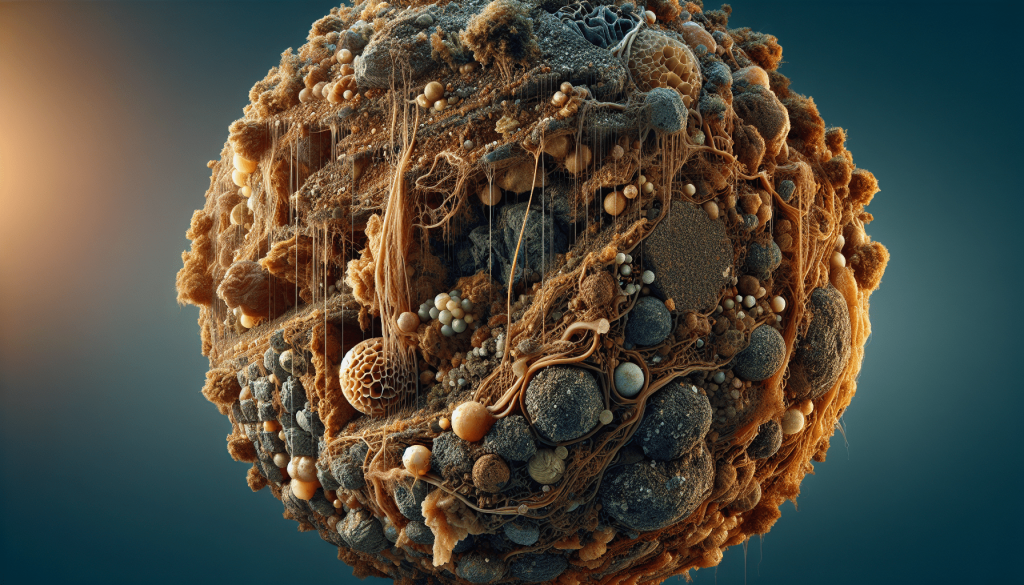This post may contain affiliate links. As an Amazon Associate, we may earn commissions from qualifying purchases.
In “The Science Behind Soil Structure And How To Improve It For Better Root Growth,” you will explore the fascinating world beneath your feet, uncovering the vital role that soil structure plays in plant health. By understanding the components and characteristics of soil, you can learn how to create an optimal environment for roots to thrive. From the importance of soil texture and composition to practical tips for enhancing soil quality, this guide provides you with the knowledge and tools needed to transform your garden into a flourishing oasis. Whether you’re a seasoned gardener or just starting out, these insights will help you nurture robust and healthy plants. Have you ever wondered why some plants thrive while others struggle, even when you give them the same water, sunlight, and care? The secret could lie beneath the surface—in the very soil that cradles their roots. Soil structure plays a pivotal role in plant health, yet it remains an often overlooked aspect of gardening and agriculture. Let’s dive into the science behind soil structure and discover how you can improve it for optimal root growth and plant vitality.
Understanding Soil Structure
First, let’s break down what soil structure really is. Soil structure refers to the arrangement of soil particles (sand, silt, and clay) and the pore spaces between them. These particles often clump together to form aggregates, and the way these aggregates are arranged determines how air, water, and nutrients move through the soil.
Components of Soil Structure
Soil structure consists of several components, each contributing to the overall health of your soil. Here’s a simple breakdown:
| Component | Description |
|---|---|
| Sand | Large particles measuring 0.05-2 mm in diameter. |
| Silt | Medium-sized particles measuring 0.002-0.05 mm in diameter. |
| Clay | Small particles measuring less than 0.002 mm in diameter. |
| Organic Matter | Decomposed plant and animal remains. |
| Pore Spaces | The gaps between soil particles that hold air, water, and roots. |
Types of Soil Structure
Soil structure comes in different types, each impacting the soil’s behavior and suitability for plant growth. Here are the main types:
| Soil Structure Type | Description | Ideal Conditions |
|---|---|---|
| Granular | Small, rounded aggregates. | Excellent for root growth due to good air and water movement. |
| Platy | Flat, plate-like aggregates. | Poor for root growth; common in compacted soil. |
| Blocky | Irregular, block-like aggregates. | Moderate conditions; may need improvement for better growth. |
| Prismatic | Vertical, column-like aggregates. | Often found in subsoil; good vertical root penetration but poor lateral movement. |
The Science Behind Soil Aggregation
The key to great soil structure lies in soil aggregation. Aggregation refers to how soil particles bond together to form larger clumps or clusters. These aggregates are stabilized by a mix of organic matter, fungal hyphae, polysaccharides (natural glue-like substances from microorganisms), and plant roots. When soil aggregates are well-formed, they promote the healthy movement of air and water, vital for root growth and nutrient uptake.
Forces and Factors in Soil Aggregation
Several forces and factors contribute to soil aggregation. Understanding them can help you make informed decisions to improve your soil structure:
- Organic Matter: Organic matter acts as a binding agent, improving aggregate stability.
- Soil Microorganisms: Bacteria and fungi produce substances that cement soil particles together.
- Plant Roots: Roots physically bind soil particles, and root exudates (substances secreted by roots) can enhance aggregation.
- Water Content: The right amount of moisture helps in the binding process, but too much can lead to dispersion and loss of structure.
- Tillage Practices: Gentle tillage can help mix components, but excessive tillage breaks down aggregates and compacts the soil.

Assessing Your Soil Structure
Before making any improvements, it’s essential to understand your soil’s current structure. Here’s how you can assess it:
- Visual Examination: Dig a small hole and look at the soil profile. Observe the shape and feel of the soil aggregates.
- Feel Test: Rub a small amount of moist soil between your fingers. Granular or crumbly soil indicates good structure, while a sticky, cloddy feeling may suggest compaction or poor structure.
- Drainage Test: Dig a hole and fill it with water. If it drains quickly, your soil might have good structure. Slow drainage can indicate poor aggregation or compaction.
- Root Examination: Uproot a small plant. Observe how easy it is to remove the plant and inspect the root system. Fine, widespread roots suggest good soil structure.
Improving Soil Structure
Improving soil structure is a multi-step process that involves adding organic matter, employing proper tillage techniques, and managing water wisely. Let’s explore these strategies in detail.
Adding Organic Matter
Organic matter is the cornerstone of good soil structure. It improves aggregation, water retention, and nutrient availability.
- Compost: Add compost to your soil to provide essential nutrients and improve aggregation.
- Cover Crops: Plant cover crops like clover or rye during off-seasons. These crops add organic matter and improve soil structure when incorporated back into the soil.
- Mulching: Apply a layer of mulch to retain soil moisture, reduce erosion, and gradually add organic matter.
Proper Tillage Practices
Tillage can either enhance or destroy soil structure depending on how it’s done. Gentle and strategic tillage practices can help improve soil structure without the adverse effects of compaction.
- Avoid Over-Tilling: Excessive tillage can break down aggregates and lead to compaction.
- No-Till Methods: Consider no-till or reduced-till farming to preserve soil structure.
- Aeration: Use aeration tools to make small holes in the soil, improving air and water flow without disturbing the aggregate structure.
Water Management
Proper watering techniques ensure that soil remains at the ideal moisture level for aggregation.
- Avoid Over-Watering: Too much water can disperse soil particles and destroy aggregates.
- Drip Irrigation: Use drip irrigation systems to deliver water directly to the root zone, minimizing water loss and soil disturbance.
- Rain Gardens: Construct rain gardens to manage excess water and prevent erosion.

The Role of Soil Amendments
Soil amendments can further help improve soil structure. Here are some effective amendments:
| Amendment | Benefits |
|---|---|
| Gypsum | Breaks up compacted soil and improves water infiltration. |
| Lime | Raises soil pH (for acidic soils) and enhances microbial activity. |
| Biochar | Improves water retention, aeration, and nutrient availability. |
| Green Manure | Adds organic matter and nutrients. Plant it, then till it into the soil. |
Monitoring and Maintenance
Improving soil structure is an ongoing process. Regular monitoring and maintenance are crucial to ensure long-term success.
Soil Testing
Regular soil testing helps you understand the nutrient levels and pH of your soil, enabling you to make precise amendments.
- Nutrient Test: Check for levels of essential nutrients like nitrogen, phosphorus, and potassium.
- pH Test: Ensure your soil’s pH is within the optimal range for your specific plants (usually 6.0-7.5).
Continuous Organic Matter Addition
Continuously adding organic matter ensures sustained soil health.
- Seasonal Composting: Add compost at least once a season to maintain high organic matter levels.
- Rotate Cover Crops: Switch up your cover crops to provide diverse organic contributions.
Mulching
Maintain a consistent mulch layer to protect the soil surface and enhance organic matter levels.
- Natural Mulch: Use straw, grass clippings, or wood chips.
- Synthetic Mulch: Consider landscape fabric for weed control, supplemented with organic mulch for added benefits.
Case Study: Transforming Poor Soil
Let’s look at a real-world example to understand how these strategies work together to transform poor soil into a thriving environment for plants.
Initial Conditions
- Soil Type: Heavy clay
- Problems: Poor drainage, compaction, limited root growth, low organic matter
Action Plan
- Initial Assessment: Conducted visual and feel tests, drainage test, and root examination.
- Organic Matter Addition: Added 2 inches of compost and planted cover crops.
- Proper Tillage: Employed reduced-till practices to incorporate cover crops.
- Water Management: Installed a drip irrigation system.
- Soil Amendment: Added gypsum to break up compacted clay layers.
Results
- Improved Drainage: Water flowed more freely through the soil.
- Better Root Growth: Plants developed a more extensive, healthier root system.
- Increased Organic Matter: Enhanced aggregation and nutrient levels.
Ongoing Maintenance
- Regular Composting: Continued seasonal compost applications.
- Soil Testing: Conducted annual soil tests to monitor nutrient levels and pH.
- Cover Crop Rotation: Rotated cover crops to keep the soil nutrient-rich and well-structured.
Conclusion
Improving soil structure is essential for optimal plant growth and overall soil health. By understanding the science behind soil structure, assessing your current soil conditions, and employing strategies to enhance soil aggregation, you can create an environment where roots thrive. Incorporating organic matter, practicing gentle tillage, and managing water effectively are crucial steps in this journey. Remember, soil health is an ongoing commitment, and with regular monitoring and maintenance, your plants will thank you with robust root systems and bountiful harvests.
So next time you plant something new, take a moment to pay attention to the soil beneath your feet—because great gardens and crops start from the ground up!








